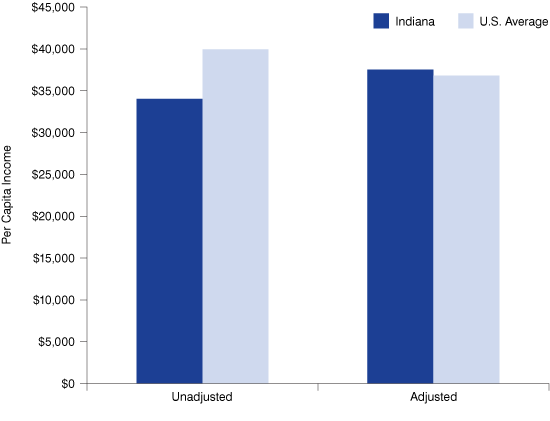Does Cost of Living Affect Indiana Incomes?
Governmental statistics are provided and disseminated freely for use by researchers, policymakers and interested parties. However, these statistics often need clarification and contextualization. One example is Indiana's per capita income, which often finds itself in the press because it lags the national average. Taken at face value, this statistic is very sobering. Using 2010 data supplied by the Indiana Department of Workforce Development website (www.Hoosierdata.in.gov) and STATS Indiana (www.stats.indiana.edu), this article explores per capita income and the impact of cost of living adjustments. It briefly examines the influence of regional price adjustments and education in a crude and simplified manner as a first step in determining their impact on the differential between Indiana and U.S. incomes.
As shown in Table 1, Indiana per capita incomes lag behind the national average by 14.8 percent (or $5,903) and rank 42nd out of the 51 geographies examined (U.S. states plus the District of Columbia). It certainly makes for a compelling case for Indiana administrative officials to tackle this issue and reduce the size of this gap.
Table 1: Per Capita Income, 2010
| Geography | Per Capita Income | Rank* |
|---|---|---|
| Indiana | $34,042 | 42 |
| U.S. Average | $39,945 | |
| Differential | -14.8% |
* Rank among the 50 states plus the District of Columbia
Source: Indiana Department of Workforce Development
While attempting to increase the incomes within one's state is a laudable task, the current situation might not be nearly as dour as perceived at first glance if one is focusing only on income rather than standard of living.
Most people understand that a dollar in Indiana does not have the same purchasing power in New York City, Chicago or San Francisco. Adjusting the wage data ensures that differences in cost of living are reflected. It is reasonable to assume that someone earning $30,000 in Indianapolis would maintain more purchasing power than someone earning the same income in New York City. ACCRA (www.coli.org) provides estimates for cost of living adjustments on many metro areas. Combining the list of metro areas, along with their cost of living indexes, and population statistics from the U.S. Census Bureau a rough statewide weighted average cost of living index (COLI) adjuster was calculated.
Utilizing this COLI adjuster, Indiana adjusted per capita incomes are 2 percent (or $719) higher than the adjusted national average, as shown in Table 2. The ranking of adjusted incomes increased to 26th, showing that Indiana incomes hold up rather well to the national average after accounting for cost of living (see Figure 1).
Table 2: Per Capita Income Adjusted for Cost of Living, 2010
| Geography | Adjusted Per Capita Income | Rank* |
|---|---|---|
| Indiana | $37,538 | 26 |
| U.S. Average | $36,819 | |
| Differential (in %) | 2.0% |
* Rank among the 50 states plus the District of Columbia
Source: Indiana Department of Workforce Development
Figure 1: Per Capita Income Comparison, 2010

Source: Indiana Department of Workforce Development
Indiana also ranks 44th in the percentage of adults with a bachelor's degree or more, based on 2009 Census data. Since educational attainment is an important factor in determining income levels, the fact that Indiana has maintained an adjusted income near the national average—despite low levels of college attainment—speaks somewhat to the vibrancy of its employment market. While public policy research should be focused on increasing incomes and educational attainment, the general perception that Indiana salaries lag nationally can be mitigated somewhat by adjustments.
It should be noted that the standard deviation of per capita incomes across states after adjustment fell by 38 percent indicating a reduction of variation. This finding is consistent with purchasing power parity. If opportunities of real wage disparity existed across state lines, arbitrage would exist and work to eliminate such variation. The limitations of this analysis are without question. The cost of living index adjustment could use further refinement and no modeling attempt was conducted on education. It is hoped that this analysis will foster further research to help clarify and correctly interpret the income data.
![]() Download the summary data of these findings.
Download the summary data of these findings.
Timothy E. Zimmer, Ph.D.
Manager, Research and Analysis Division of the Indiana Department of Workforce Development
Kimberley Linville
Program Director, Economic Market Analysis, Research and Analysis Division of the Indiana Department of Workforce Development
